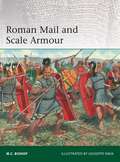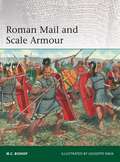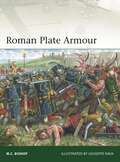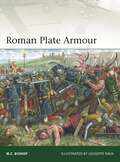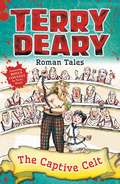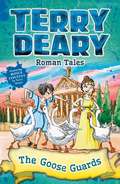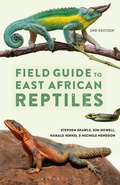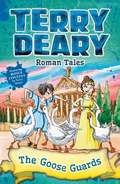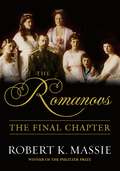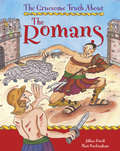- Table View
- List View
Roman Legionary vs Gallic Warrior: 58–52 BC (Combat)
by David CampbellIn the manner of many Roman generals, Caesar would write his domestic political ambitions in the blood and treasure of foreign lands. His governorship of Cisalpine Gaul gave him the opportunity to demonstrate the greatness of his character to the people of Rome through the subjugation of those outside Rome's borders. The fact that the main account of the subsequent wars in Gaul was written by Caesar himself – by far the most detailed history of the subject, with new reports issued annually for the eager audience at home –is no accident. The Roman Army of the late Republic had long been in the process of structural and change, moving towards the all-volunteer permanent standing force that would for centuries be the bulwark of the coming Empire. Well-armed and armoured, this professional army was trained to operate within self-supporting legions, with auxiliaries employed in roles the legions lacked such as light troops or cavalry. The Roman legions were in many ways a modern force, with formations designed around tactical goals and held together by discipline, training and common purpose. The armies fielded by the tribes of Gaul were for the most part lightly armed and armoured, with fine cavalry and a well-deserved reputation for ferocity. As might be expected from a region made up of different tribes with a range of needs and interests, there was no consensus on how to make war, though when large armies were gathered it was usually with the express purpose of bringing the enemy to heel in a pitched battle. For most Gauls – and certainly the military elites of the tribes – battle was an opportunity to prove their personal courage and skill, raising their status in the eyes of friends and foes alike. Fully illustrated, this study investigates the Roman and Gallic forces pitched into combat in three battles: Bibracte (58 BC), Sabis (57 BC) and Gergovia/Alesia (52 BC). Although charismatic Gallic leaders did rise up – notably Dumnorix of the Aedui and later Vercingetorix of the Arverni – and proved to be men capable of bringing together forces that had the prospect of checking Caesar's ambitions in the bloodiest of ways, it would not be enough. For Caesar his war against the Gauls provided him with enormous power and the springboard he needed to make Rome his own, though his many domestic enemies would ensure that he did not long enjoy his success.
Roman Legionary vs Gallic Warrior: 58–52 BC (Combat)
by David CampbellIn the manner of many Roman generals, Caesar would write his domestic political ambitions in the blood and treasure of foreign lands. His governorship of Cisalpine Gaul gave him the opportunity to demonstrate the greatness of his character to the people of Rome through the subjugation of those outside Rome's borders. The fact that the main account of the subsequent wars in Gaul was written by Caesar himself – by far the most detailed history of the subject, with new reports issued annually for the eager audience at home –is no accident. The Roman Army of the late Republic had long been in the process of structural and change, moving towards the all-volunteer permanent standing force that would for centuries be the bulwark of the coming Empire. Well-armed and armoured, this professional army was trained to operate within self-supporting legions, with auxiliaries employed in roles the legions lacked such as light troops or cavalry. The Roman legions were in many ways a modern force, with formations designed around tactical goals and held together by discipline, training and common purpose. The armies fielded by the tribes of Gaul were for the most part lightly armed and armoured, with fine cavalry and a well-deserved reputation for ferocity. As might be expected from a region made up of different tribes with a range of needs and interests, there was no consensus on how to make war, though when large armies were gathered it was usually with the express purpose of bringing the enemy to heel in a pitched battle. For most Gauls – and certainly the military elites of the tribes – battle was an opportunity to prove their personal courage and skill, raising their status in the eyes of friends and foes alike. Fully illustrated, this study investigates the Roman and Gallic forces pitched into combat in three battles: Bibracte (58 BC), Sabis (57 BC) and Gergovia/Alesia (52 BC). Although charismatic Gallic leaders did rise up – notably Dumnorix of the Aedui and later Vercingetorix of the Arverni – and proved to be men capable of bringing together forces that had the prospect of checking Caesar's ambitions in the bloodiest of ways, it would not be enough. For Caesar his war against the Gauls provided him with enormous power and the springboard he needed to make Rome his own, though his many domestic enemies would ensure that he did not long enjoy his success.
Roman Mail and Scale Armour (Elite #252)
by M.C. BishopFully illustrated, this study investigates the origins, evolution and use of the mail and scale armour worn by the soldiers and gladiators of Imperial Rome.Less glamorous than the Roman Army's instantly recognizable plate armour but much more versatile, mail and scale armour were used by both legionaries and auxiliaries throughout Rome's history. Developed by the Celts and quickly adopted by the Romans, mail armour was easy to make and required little maintenance. Scale was a much older form of armour, originating in the Near East during the second millennium BC. As with mail, it was used by both auxiliaries and legionaries, but like plate armour, it was much more fragile than mail. Both types of armour were also used by gladiators (principally as arm defences).New discoveries in both mail and scale, as well as in hybrid forms that mixed the two, mean that much more is now known about the development of these types of defence during the Roman period, their efficacy in battle and how they were manufactured and repaired. Featuring specially commissioned artwork and drawing upon the latest findings, this study lifts the veil on the mail and scale armour used by soldiers, gladiators and others during the heyday of Imperial Rome.
Roman Mail and Scale Armour (Elite #252)
by M.C. BishopFully illustrated, this study investigates the origins, evolution and use of the mail and scale armour worn by the soldiers and gladiators of Imperial Rome.Less glamorous than the Roman Army's instantly recognizable plate armour but much more versatile, mail and scale armour were used by both legionaries and auxiliaries throughout Rome's history. Developed by the Celts and quickly adopted by the Romans, mail armour was easy to make and required little maintenance. Scale was a much older form of armour, originating in the Near East during the second millennium BC. As with mail, it was used by both auxiliaries and legionaries, but like plate armour, it was much more fragile than mail. Both types of armour were also used by gladiators (principally as arm defences).New discoveries in both mail and scale, as well as in hybrid forms that mixed the two, mean that much more is now known about the development of these types of defence during the Roman period, their efficacy in battle and how they were manufactured and repaired. Featuring specially commissioned artwork and drawing upon the latest findings, this study lifts the veil on the mail and scale armour used by soldiers, gladiators and others during the heyday of Imperial Rome.
Roman Plate Armour (Elite)
by M.C. BishopFully illustrated, this book investigates the articulated plate armour worn by Roman legionaries.First named by Renaissance historians studying the reliefs on Trajan's Column, lorica segmentata evaded successful attempts to reconstruct it until a series of important archaeological finds in the 20th century revealed how it worked and the truth of its extended chronology. The earliest finds date from the late 1st century BC, and its discovery at Kalkriese in Germany shows how rapidly it was adopted. At the same time, discoveries in Spain and Britain showed that, despite its apparent fragility, it continued in use into the 4th century AD.The spectacular find of six halves of cuirasses in a chest at Corbridge in 1964 has now been matched by the rare discovery of a complete set of this armour at Kalkriese. The Corbridge find provided the context to interpret and reconstruct earlier finds. There is now years of experience gleaned from reenactors over the practical strengths and weaknesses of this form of armour. At the same time, scientific analysis has provided insights into the technology behind this revolutionary form of armour so characteristic of the Roman Army. Featuring specially commissioned artwork and drawing upon the latest findings, this study lifts the veil on the formidable plate armour used by the legionaries of Imperial Rome.
Roman Plate Armour: A Handbook Of Roman Plate Armour (Elite #247)
by M.C. BishopFully illustrated, this book investigates the articulated plate armour worn by Roman legionaries.First named by Renaissance historians studying the reliefs on Trajan's Column, lorica segmentata evaded successful attempts to reconstruct it until a series of important archaeological finds in the 20th century revealed how it worked and the truth of its extended chronology. The earliest finds date from the late 1st century BC, and its discovery at Kalkriese in Germany shows how rapidly it was adopted. At the same time, discoveries in Spain and Britain showed that, despite its apparent fragility, it continued in use into the 4th century AD.The spectacular find of six halves of cuirasses in a chest at Corbridge in 1964 has now been matched by the rare discovery of a complete set of this armour at Kalkriese. The Corbridge find provided the context to interpret and reconstruct earlier finds. There is now years of experience gleaned from reenactors over the practical strengths and weaknesses of this form of armour. At the same time, scientific analysis has provided insights into the technology behind this revolutionary form of armour so characteristic of the Roman Army. Featuring specially commissioned artwork and drawing upon the latest findings, this study lifts the veil on the formidable plate armour used by the legionaries of Imperial Rome.
Roman Shields (Elite)
by M.C. BishopThe introduction of the scutum in the 4th century BC revolutionized the way the Romans fought. Instead of being purely defensive, the shield became a weapon in its own right. Using the top edge or boss to punch an opponent, or the lower rim to smash down on their feet, it served to unbalance an enemy and allow the sword to do its work. The versatility of the scutum was characterized by the testudo, a formation the Romans used offensively like a pedestrian tank. Meanwhile, other shield types equipped the auxiliaries who fought alongside the legionaries. The curved, rectangular scutum survived into the 3rd century AD, only to be replaced by an oval, slightly domed shield derived from the oval shields of Early Imperial auxiliaries.Drawing together historical accounts, excavated artefacts and the results of the latest scientific analyses of the boards and fittings, renowned authority M.C. Bishop reveals the development, technology, training and use of the scutum and other Roman shield types.
Roman Shields (Elite #234)
by M.C. BishopThe introduction of the scutum in the 4th century BC revolutionized the way the Romans fought. Instead of being purely defensive, the shield became a weapon in its own right. Using the top edge or boss to punch an opponent, or the lower rim to smash down on their feet, it served to unbalance an enemy and allow the sword to do its work. The versatility of the scutum was characterized by the testudo, a formation the Romans used offensively like a pedestrian tank. Meanwhile, other shield types equipped the auxiliaries who fought alongside the legionaries. The curved, rectangular scutum survived into the 3rd century AD, only to be replaced by an oval, slightly domed shield derived from the oval shields of Early Imperial auxiliaries.Drawing together historical accounts, excavated artefacts and the results of the latest scientific analyses of the boards and fittings, renowned authority M.C. Bishop reveals the development, technology, training and use of the scutum and other Roman shield types.
Roman Siege Warfare
by Josh LevithanRoman siege warfare had its own structure and customs, and expectations both by the besieged and by the attacking army. Sieges are typically sorted by the techniques and technologies that attackers used, but the more fruitful approach offered in Roman Siege Warfare examines the way a siege follows or diverges from typical narrative and operational plotlines. Author Josh Levithan emphasizes the human elements—morale and motivation—rather than the engineering, and he recaptures the sense of a siege as an event in progress that offers numerous attitudes, methods, and outcomes. Sieges involved a concentration of violent effort in space and the practical challenge posed by a high wall: unlike field battles they were sharply defined in time, in space, and in operational terms. Chapters examine motivation and behavior during a siege and focus on examples from both the Roman Republic and the Empire: Polybius, Livy, Julius Caesar, Flavius Josephus, and Ammianus Marcellinus. Levithan examines the “gadgetary turn,” during which writers began to lavish attention on artillery and wall-damaging techniques, fetishizing technology and obscuring the centrality of the assault and of human behavior. This volume speaks to classicists and historians of all stripes. All passages are translated, and references are accessible to nonspecialists. Military historians will also find much of interest in the volume, in its treatment both of Roman military conduct and of wider military practice.
Roman Soldier vs Germanic Warrior: 1st Century AD (Combat)
by Peter Dennis Lindsay PowellThe reigns of Augustus and his successor Tiberius saw an epic struggle between the Romans and local peoples for the territory between the Rhine and Elbe rivers in what is now Germany. Following two decades of Roman occupation, Germania Magna erupted into revolt in AD 9 following the loss of the three legions commanded by Publius Quinctilius Varus to the Cheruscan nobleman Arminius and an alliance of Germanic nations in the dense forests of the Teutoburger Wald. The Romans' initial panic subsided as it became clear that Arminius and his allies could not continue the war into Germania Inferior on the western bank of the Rhine, and Imperial troops poured into the region as the Romans decided how best to resolve the situation. Featuring full-colour artwork, specially drawn maps and an array of revealing illustrations depicting weapons, equipment, key locations and personalities, this study offers key insights into the tactics, leadership, combat performance and subsequent reputations of the Roman soldiers and their Germanic opponents pitched into a series of pivotal actions on the Imperial frontier that would influence Roman/German relations for decades to come.
Roman Soldier vs Germanic Warrior: 1st Century AD (Combat)
by Peter Dennis Lindsay PowellThe reigns of Augustus and his successor Tiberius saw an epic struggle between the Romans and local peoples for the territory between the Rhine and Elbe rivers in what is now Germany. Following two decades of Roman occupation, Germania Magna erupted into revolt in AD 9 following the loss of the three legions commanded by Publius Quinctilius Varus to the Cheruscan nobleman Arminius and an alliance of Germanic nations in the dense forests of the Teutoburger Wald. The Romans' initial panic subsided as it became clear that Arminius and his allies could not continue the war into Germania Inferior on the western bank of the Rhine, and Imperial troops poured into the region as the Romans decided how best to resolve the situation. Featuring full-colour artwork, specially drawn maps and an array of revealing illustrations depicting weapons, equipment, key locations and personalities, this study offers key insights into the tactics, leadership, combat performance and subsequent reputations of the Roman soldiers and their Germanic opponents pitched into a series of pivotal actions on the Imperial frontier that would influence Roman/German relations for decades to come.
Roman Soldier vs Parthian Warrior: Carrhae to Nisibis, 53 BC–AD 217 (Combat)
by Si SheppardIn 53 BC, Roman and Parthian forces collided in a confrontation that would reshape the geopolitical map and establish a frontier between East and West that would endure for the next 700 years. From the initial clash at Carrhae through to the battle of Nisibis more than 250 years later, Roman and Parthian forces fought a series of bloody campaigns for mastery of the Fertile Crescent.As Roman forces thrust ever deeper into the East, they encountered a civilization unlike any they had crossed swords with before. Originating in the steppes of Central Asia, the Parthians ruled a federated state stretching from the Euphrates to the Indus. Although Rome's legions were masters of the battlefield in the Mediterranean, the Parthians refused to fight by the rules as Rome understood them. Harnessing the power of the composite bow and their superior manoeuvrability, the Parthians' mode of warfare focused exclusively on the horse. They inflicted a bloody defeat on the legions at Carrhae and launched their own invasion of Roman territory, countered only with great difficulty by Rome's surviving forces. The Parthians were eventually thrown out, but neither side could sustain a permanent ascendancy over the other and the conflict continued.Packed with stunning artwork, including battlescenes, maps and photographs, this title examines the conflict through the lens of three key battles, revealing a clash between two armies alien to each other not only in culture but also in their radical approaches to warfare.
Roman Soldier vs Parthian Warrior: Carrhae to Nisibis, 53 BC–AD 217 (Combat)
by Si SheppardIn 53 BC, Roman and Parthian forces collided in a confrontation that would reshape the geopolitical map and establish a frontier between East and West that would endure for the next 700 years. From the initial clash at Carrhae through to the battle of Nisibis more than 250 years later, Roman and Parthian forces fought a series of bloody campaigns for mastery of the Fertile Crescent.As Roman forces thrust ever deeper into the East, they encountered a civilization unlike any they had crossed swords with before. Originating in the steppes of Central Asia, the Parthians ruled a federated state stretching from the Euphrates to the Indus. Although Rome's legions were masters of the battlefield in the Mediterranean, the Parthians refused to fight by the rules as Rome understood them. Harnessing the power of the composite bow and their superior manoeuvrability, the Parthians' mode of warfare focused exclusively on the horse. They inflicted a bloody defeat on the legions at Carrhae and launched their own invasion of Roman territory, countered only with great difficulty by Rome's surviving forces. The Parthians were eventually thrown out, but neither side could sustain a permanent ascendancy over the other and the conflict continued.Packed with stunning artwork, including battlescenes, maps and photographs, this title examines the conflict through the lens of three key battles, revealing a clash between two armies alien to each other not only in culture but also in their radical approaches to warfare.
Roman Standards & Standard-Bearers: AD 192–500 (Elite)
by Raffaele D’AmatoThe Late Roman Empire was a period of significant change in the designs of standards and in the costumes of standard-bearers. During the middle decades of the chaotic 3rd century, evidence confirms the continued use of the old legionary eagle and the signa of the old cohorts and centuries, alongside flags and Imperial images. The two major trends over the later generations were the adoption of Christian symbols on standards (e.g. Constantine the Great's Chi-Rho), and the proliferation of different types of flags. This had begun in the late 2nd century with the adoption of the 'barbarian' dragon standard, the windsock-shaped draco, which continued to be displayed alongside various other flags in the Greek-speaking Eastern Empire, whose influence increased greatly. Meanwhile, the growing employment of foreign units was such that by the 5th century we have evidence of the use of Hunnic symbolism among a Roman general's suite of standards. The costumes of standard-bearers also evolved as 'Persian' styles spread from Constantinople.This title explores all these changes in depth, charting the development of various costumes and designs and the waxing and waning influence of various cultures and religious considerations. The text is supported by specially commissioned illustrations and artist's reconstructions of the standards and their bearers.
Roman Standards & Standard-Bearers: AD 192–500 (Elite #230)
by Raffaele D’AmatoThe Late Roman Empire was a period of significant change in the designs of standards and in the costumes of standard-bearers. During the middle decades of the chaotic 3rd century, evidence confirms the continued use of the old legionary eagle and the signa of the old cohorts and centuries, alongside flags and Imperial images. The two major trends over the later generations were the adoption of Christian symbols on standards (e.g. Constantine the Great's Chi-Rho), and the proliferation of different types of flags. This had begun in the late 2nd century with the adoption of the 'barbarian' dragon standard, the windsock-shaped draco, which continued to be displayed alongside various other flags in the Greek-speaking Eastern Empire, whose influence increased greatly. Meanwhile, the growing employment of foreign units was such that by the 5th century we have evidence of the use of Hunnic symbolism among a Roman general's suite of standards. The costumes of standard-bearers also evolved as 'Persian' styles spread from Constantinople.This title explores all these changes in depth, charting the development of various costumes and designs and the waxing and waning influence of various cultures and religious considerations. The text is supported by specially commissioned illustrations and artist's reconstructions of the standards and their bearers.
Roman Tales: The Captive Celt (Roman Tales)
by Terry Deary Helen FlookFrom the bestselling author of Horrible Histories...AD 51Bran is a slave, a prisoner of Rome, but dreams of one day returning to his homeland, Britannia, to fight against the Romans. When the proud young slave is overheard criticizing Rome, he is thrown into prison and faces execution the next day. Luckily, his cell mate Caratacus is a very special prisoner indeed - a British chief. He believes he has a way to save both their skins, but he'll need Bran's help.A tale based on a key moment in Roman history, full of Terry Deary's dark humour and dry wit.Book band: BrownIdeal for ages 7+Quizzed for Accelerated Reader
Roman Tales: The Goose Guards (Roman Tales)
by Terry Deary Helen FlookFrom the bestselling author of Horrible Histories...387 BC Rome is under attack from the vicious Gauls and the barbarian army is now preparing to besiege the Temple of Juno on Capitol Hill, home of Brutus, a trainee priest. The temple's inhabitants are offered help from the army of Lord Furius, but are not sure if he is to be trusted. However, when rescue eventually comes it is from an even moreunlikely source...A tale based on one of the most famous of all Roman legends, full of Terry Deary's dark humour and dry wit.Book band: GreyIdeal for ages 8+Quizzed for Accelerated Reader
Roman Tales: The Captive Celt (Roman Tales)
by Terry Deary Helen FlookFrom the bestselling author of Horrible Histories...AD 51Bran is a slave, a prisoner of Rome, but dreams of one day returning to his homeland, Britannia, to fight against the Romans. When the proud young slave is overheard criticizing Rome, he is thrown into prison and faces execution the next day. Luckily, his cell mate Caratacus is a very special prisoner indeed - a British chief. He believes he has a way to save both their skins, but he'll need Bran's help.A tale based on a key moment in Roman history, full of Terry Deary's dark humour and dry wit.Book band: BrownIdeal for ages 7+Quizzed for Accelerated Reader
Roman Tales: The Goose Guards (Roman Tales)
by Terry Deary Helen FlookFrom the bestselling author of Horrible Histories...387 BC Rome is under attack from the vicious Gauls and the barbarian army is now preparing to besiege the Temple of Juno on Capitol Hill, home of Brutus, a trainee priest. The temple's inhabitants are offered help from the army of Lord Furius, but are not sure if he is to be trusted. However, when rescue eventually comes it is from an even moreunlikely source...A tale based on one of the most famous of all Roman legends, full of Terry Deary's dark humour and dry wit.Book band: GreyIdeal for ages 8+Quizzed for Accelerated Reader
Romania 1944: The Turning of Arms against Nazi Germany (Campaign #404)
by Grant HarwardThe complex and fascinating story of Romania's 'turning of arms' against Nazi Germany, and the battle for Romania - an important but overlooked and misunderstood episode of World War II. The battle for Romania from March to September 1944 is a multifaceted story involving German, Romanian, Soviet, American, and British forces. Romania's defection from the Axis denied Nazi Germany not just resources (especially oil) but also turned the Romanian Army, formerly its most important support on the Eastern Front, from friend to foe. The fighting witnessed the German Sixth Army being destroyed for a second time (after Stalingrad).This in-depth work explores the strategic struggle within German-Romanian relations and the tactical development of the Battle of Romania. The detailed 2D maps and 3D diagrams guide you step-by-step through the Axis defence of Romania in March-May during the first Iasi-Chisinau offensive, the Allied campaign in April-August to assist the Soviets, the Axis collapse in August during the second Iasi-Chisinau offensive, the Romanian defeat of the attempted German counter-coup, and the final Soviet occupation of Romania. Period photographs from the Romanian archives and private collections, many never before seen, and stunning battlescene artworks bring to life the soldiers and materiel of the wide range of forces involved in this rarely explored Eastern Front campaign.
Romania 1944: The Turning of Arms against Nazi Germany (Campaign #404)
by Grant HarwardThe complex and fascinating story of Romania's 'turning of arms' against Nazi Germany, and the battle for Romania - an important but overlooked and misunderstood episode of World War II. The battle for Romania from March to September 1944 is a multifaceted story involving German, Romanian, Soviet, American, and British forces. Romania's defection from the Axis denied Nazi Germany not just resources (especially oil) but also turned the Romanian Army, formerly its most important support on the Eastern Front, from friend to foe. The fighting witnessed the German Sixth Army being destroyed for a second time (after Stalingrad).This in-depth work explores the strategic struggle within German-Romanian relations and the tactical development of the Battle of Romania. The detailed 2D maps and 3D diagrams guide you step-by-step through the Axis defence of Romania in March-May during the first Iasi-Chisinau offensive, the Allied campaign in April-August to assist the Soviets, the Axis collapse in August during the second Iasi-Chisinau offensive, the Romanian defeat of the attempted German counter-coup, and the final Soviet occupation of Romania. Period photographs from the Romanian archives and private collections, many never before seen, and stunning battlescene artworks bring to life the soldiers and materiel of the wide range of forces involved in this rarely explored Eastern Front campaign.
Romanian Counterinsurgency and its Global Context, 1944-1962
by Andrei MiroiuThis book analyses the nationalist rebellion which emerged in Romania following the Second World War. The first two decades after the end of the war were times of rebellion in imperial peripheries. Armed movements, sometimes communist but nearly always nationalist in orientation, rose in opposition to retreating or advancing imperial powers. One such armed revolt took place in Romania, pitting nationalist partisans against a communist government. This book is an analysis of how the authorities crushed this rebellion, set in the context of parallel campaigns fought in Europe and the Third World. It focuses on population control through censorship, propaganda and deportations. It analyses military operations, particularly patrols, checkpoints, ambushes and informed strikes. Intelligence operations are also discussed, with an emphasis on recruiting informants, on interrogation, torture and infiltration. Bullets, brains and barbwire, not “hearts and minds” approaches, crushed internal rebels in post-1945 campaigns.
Romania's Holy War: Soldiers, Motivation, and the Holocaust (Battlegrounds: Cornell Studies in Military History)
by Grant T. HarwardRomania's Holy War rights the widespread myth that Romania was a reluctant member of the Axis during World War II. In correcting this fallacy, Grant T. Harward shows that, of an estimated 300,000 Jews who perished in Romania and Romanian-occupied Ukraine, more than 64,000 were, in fact, killed by Romanian soldiers. Moreover, the Romanian Army conducted a brutal campaign in German-occupied Ukraine, resulting in the deaths of thousands of Soviet prisoners of war, partisans, and civilians. Investigating why Romanian soldiers fought and committed such atrocities, Harward argues that strong ideology—a cocktail of nationalism, religion, antisemitism, and anticommunism—undergirded their motivation. Romania's Holy War draws on official military records, wartime periodicals, soldiers' diaries and memoirs, subsequent war crimes investigations, and recent interviews with veterans to tell the full story. Harward integrates the Holocaust into the narrative of military operations to show that most soldiers fully supported the wartime dictator, General Ion Antonescu, and his regime's holy war against "Judeo-Bolshevism." The army perpetrated mass reprisals, targeting Jews in liberated Romanian territory; supported the deportation and concentration of Jews in camps or ghettos in Romanian-occupied Soviet territory; and played a key supporting role in SS efforts to exterminate Jews in German-occupied Soviet territory. Harward proves that Romania became Nazi Germany's most important ally in the war against the USSR because its soldiers were highly motivated, thus overturning much of what we thought we knew about this theater of war. Romania's Holy War provides the first complete history of why Romanian soldiers fought on the Eastern Front.
The Romanovs: The Terrible Fate Of Russia's Last Tsar And His Family (Great Lives)
by Robert K. MassieThe compelling quest to solve a great mystery of the twentieth century: the ultimate fate of Russia's last tsar and his family.In July 1991, nine skeletons were exhumed from a shallow grave near Ekaterinburg, Siberia, a few miles from the infamous cellar where the last tsar and his family had been murdered seventy-three years before. Were these the bones of the Romanovs? If so, why were the bones of the two younger Romanovs missing? Was Anna Anderson, celebrated in newspapers, books, and film, really Grand Duchess Anastasia?This book unearths the truth. Pulitzer Prize winner Robert K. Massie presents a colourful panorama of contemporary characters, illuminating the major scientific dispute between Russian experts and a team of Americans, whose findings – along with those of DNA scientists from Russia, America, and the UK – all contributed to solving one of history's most intriguing mysteries.
The Romans: Romans (The Gruesome Truth About #14)
by Jillian PowellCovering different historical eras, this informative series details all the topics one would expect to find in a history series, such as family life, food, religion, entertainment and warfare. However, it focuses on the most gruesome parts of these topics.


